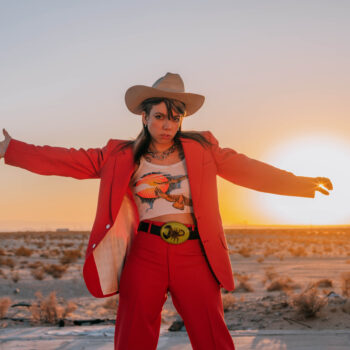“I always kind of felt like I could go back in time and that something would continue to happen forever, but I think that’s just youth,” folk singer-songwriter and guitarist Alynda Mariposa Segarra, who records under the name Hurray for the Riff Raff, tells Remezcla. It was a harsh but necessary realization — the difference between staying in the past versus honoring it — and it’s one of the main themes on their latest album, The Past is Still Alive. However, it’s all easier said than done.
After their father’s passing last year, shortly before they were scheduled to start recording the album with producer Brad Cook, Segarra discloses that they were “not really totally in this world.” It then became a delicate balance of capturing where they naturally were in the grieving process without completely falling apart. “I needed to just come and be my messy self,” the singer adds. “There’s an art to being able to let go. I think that’s where I’m at now.”
The Past is Still Alive is part homage to the past, part homage to the ongoing legacy of outsider culture. Stylistically, it departs from the surrealist, punk ethos that piloted 2022’s Life On Earth and the earthier, Delta blues-influenced Small Town Heroes. Yet, it simmers with the quiet intensity of Hurray for the Riff Raff’s previous works. Tracks like “Colossus of Roads,” written in the aftermath of Colorado’s Club Q shooting in 2022, share a radical lineage with earlier protest songs like “PRECIOUS CARGO” and “The Body Electric,” where the 36-year-old songwriter took up the format of the historically misogynistic murder ballad to condemn gender violence and victim blaming culture.
But throughout this new set of songs, Segarra looks further inward to draw up eloquent, memoir-like snapshots of communion, love, and tragedy with the closeness of a late-night heart-to-heart with a lifelong friend. The Past is Still Alive overflows with tales of hopping trains, hitchhiking across the country, outrunning the cops in a small Nebraska town, and riding shotgun with enigmatic heroes like Miss Jonathan. “It felt like being with old friends again at a lonely time in my life, and it started to mean more once I lost my dad,” the artist says.
Gorgeous pedal steel fiddles, dobro guitars, and Wurlitzer organs take precedence over buzzy synths and soft dembow rhythms this time around, adding to the mystique of the South and the West that captivated Segarra enough to leave their home of New York City at just 17 years old. “Colossus” is a tender still life and a love song to queerness where the Nuyorican folk singer embodies a cowboy hat-donning James Dean-esque rebel persona and spotlights poet Eileen Myles, along with boxcar art icon buZ blur besides images of oil cans adorning grease marker graffiti.
“This is about us honoring each other and also honoring the danger — the good and the bad ways — that comes with living your authentic self,” Segarra says. “Or just being brave enough to pursue this outsider life.”
On “Snake Plant (The Past is Still Alive),” Hurray for the Riff Raff shuffles through memories of hot summers spent sneaking onto farms and reflects on rambling around with others living on the margins, looking to break away from where they came and their affection for mischief, like moonlit sex on trash islands. “Most of our old friends are dead,” Segarra laments in the song’s verses before pleading for their loved ones to do what they can to stay alive. “Test your drugs/Remember Narcan/There’s a war on the people/What don’t you understand… We need you back down here on earth/Nothing is as painful as birth.”
“I know that death feels like this better option, and this process of rebirthing yourself and staying alive is the hardest shit you’re gonna do. It makes sense that it is painful, so it’s me saying, ‘I understand just how painful this feels,’” Hurray for the Riff Raff notes. “But it’s also me saying, ‘Hey, we need you.’”
I needed to just come and be my messy self. There’s an art to being able to let go. I think that’s where I’m at now.
While this set of songs doesn’t total out to an overtly political record like 2017’s colossal conceptual album The Navigator, where the artist centralized the harsh realities of the Puerto Rican diaspora navigating a rapidly gentrifying landscape in New York City, Segarra continues to use traditional forms like Americana and folk music to eulogize outsiders and the marginalized; to have difficult conversations about the state of the world that they live in, both the beautiful and the tragic.
On “Ogallala,” what is arguably The Past is Still Alive’s most striking moment, Hurray for the Riff Raff professes, “I used to think I was born in the wrong generation/But I know now/I made it right on time/to watch the world burn, to watch the world burn/with a tear in my eye,” over swells of brass instruments and pedal steel. It’s a stout and earnest sentiment from Segarra, who has mentioned everyone from Billie Holiday, Bessie Smith, and Ma Rainey to the Young Lords and Bad Bunny as sources of inspiration and whose work often time-travels across genres and mediums.
“As a kid, I definitely felt like I was born in the wrong time at many different points in my life… I was like, ‘Dammit, I should’ve been around for the riots in the ‘80s. I should’ve been a squatter in the ‘90s…’ Now I look back and am like, ‘No, I was meant to be 14 years old when 9/11 happened because I was meant to be brought up in anti-war protests. I was meant to watch Critical Mass happen in New York every month and watch us shut down Times Square on bicycles.’ That was supposed to be a part of my education so that I could figure out a way to carry that,” they note.
“It’s about finding your role in the midst of this chaos.”







